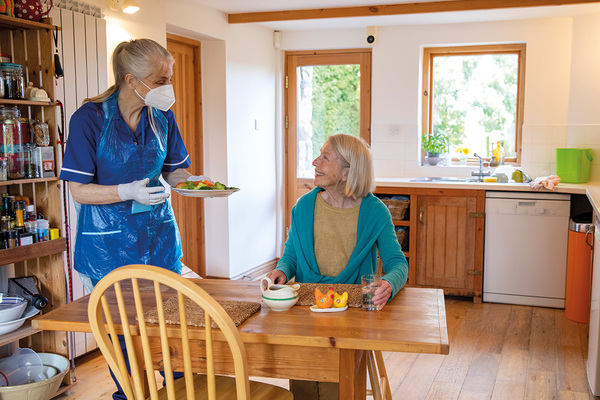You are viewing 1 of your 1 free articles
The Thinkhouse Review: are we ready? Safe and suitable homes for our ageing population
When talking about housing for older people, much of the focus is on downsizing, but equally as important is making sure existing homes are fit for purpose. New reports suggest cost-effective and beneficial ways to do just that, writes Richard Hyde
During March, 14 reports were uploaded on the Thinkhouse website. Our collection criterion (research pieces, policy publications and case studies that propose ways to increase the amount and quality of the UK’s housing stock and the related economic, social and community benefits of doing this) allows us to highlight reports that cover a range of housing-related issues. This month’s topics include homelessness, urban design, planning, tenants’ aspirations and demographics.
I have decided to focus on three reports that look at housing for older people. While much focus is made on the importance of downsizing in terms of releasing housing capacity, there can be less focus on whether our existing housing is fit and ready to meet the needs of an ageing population. These three reports provide some hugely useful insights.
The Associated Retirement Community Operators’ Housing with Care Grey Paper is a report from a trade association, but it provides some valuable policy insights. It is widely understood that housing with care settings (combining independent living with on-site care and support) has a role to play in the future of care and support for older people – so hearing what sector professionals have to say on the subject is valuable.
The report also includes chapters written from the policymakers’ perspective. Among those writing are Nick Sanderson, chief executive of Audley Villages, and Jane Ashcroft, chief executive of Anchor Hanover, who highlight the benefits of and argue for the adoption of new solutions to housing older people. Professor Les Mayhew develops this by looking at the key design and financing principles for asset-rich and income-poor pensioners. Lord Foulkes’ call for a government-led housing and care taskforce to expand the options and learn from other countries would help capture these elements. MP Damian Green suggests we look at a model of the pension system to ensure that savings are provided and can be utilised to give comfort in older age.
It will take time for these benefits to arrive, but they could be transforming. MP Dr Lisa Cameron rightly highlights the need to pay care workers better and create parity for social care with the NHS. Jeremy Porteus, chief executive of Housing LIN, concludes by setting out five key steps towards good-quality older people’s housing: better planning (‘lifetime neighbourhoods’), national design standards, investments (a range of personal finance options), consumer confidence (relevant enforceable standards), and better advice and information.
The Centre for Ageing Better’s short report, Getting our Homes in Order, into the quality of the homes lived in by someone over the age of 55, is scathing in its description of the damp, cold, inaccessibility or physical disrepair suffered by many older people. This has a huge impact on long-term health conditions of those living in such homes and the demands on the NHS, which the organisation costs at £513m over five years.
The report argues that much of this could be prevented by simple repairs and adaptations. Tenure affects people’s options around making home improvements. Renters can feel unable to carry out necessary repairs. The report recommends timely access to government grants and quality assured information and advice. Importantly it calls for regulation to make properties safe and liveable.
Finally, the All-Party Parliamentary Group for Housing and Care for Older People’s report covers housing for people with dementia and asks: “Are we ready?” It explores the policy changes needed to help people live as well as possible with dementia in their own homes.
The majority of adults living with dementia do not live in purpose-designed housing. Dementia affects both the person living with the syndrome and people who are undertaking a caring role such as a spouse or partner, son or daughter, friend or other relative.
While many people live with carers, a growing percentage of people live alone. The health and well-being of both the person living with dementia and their carers is important. The relationships that people with dementia have are as diverse as the people themselves, some may have no carers in any formal sense and others may have a network of people that they draw upon at different times.
Twenty key issues are set out covering access to the best advice and support, including advice on how to adapt their environment to live as well as possible, or to identify accommodation and services that better meet their specific needs. With the prevalence of dementia on the rise in the UK, the report argues that this can be done now if we all adopt a dementia-inclusive approach.
Readers of these three reports can be left in little doubt that more should be done to adapt our housing stock to meet the national need to provide safe and suitable homes for our ageing population. Almost all the recommendations are cost-effective and will undoubtedly have huge benefits.
I echo the call for a government-led housing and care taskforce to capture these elements and I hope readers of this piece will do so as well.
Richard Hyde is chair of the editorial panel at Thinkhouse
What is Thinkhouse?
Thinkhouse is a website set up to be repository of housing research. Its editorial panel critiques and collates the best of the most recent housing research. Click here to find out more.
Sign up for our care and support bulletin
Already have an account? Click here to manage your newsletters














